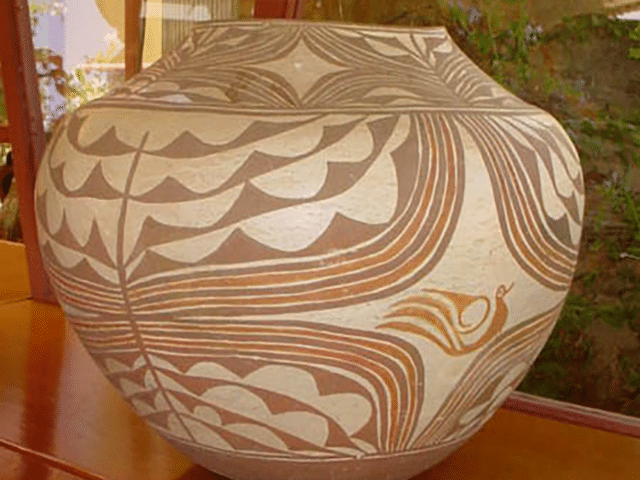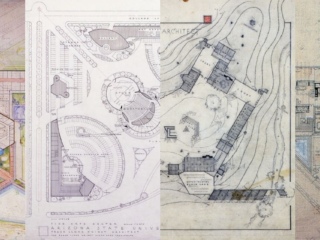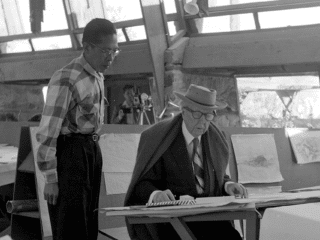![[Cohen House Tropical Foliage (Abstract Pattern Study), Eugene Masselink, ca. 1957, graphite, ink, and paint on plywood, Frank Lloyd Wright Foundation Collection, 1910.223.2.]](https://franklloydwright.org/wp-content/uploads/2024/04/1910.223.2-2-a-1289x640.png)
Celebrating World Art Day April 15, 2024
Ross Hubbard | Apr 15, 2024
World Art Day, commemorated every year on April 15, seeks to encourage the expansion, distribution, and admiration of art on a global scale. In honor of this occasion, let’s delve into some of the pieces within the Foundation’s Fine and Decorative Art Collection.
Frank Lloyd Wright enjoyed blending different pieces in his residences to create a complete work of art where architecture, visual media, and music worked together to create harmony within the spaces.
The Foundation’s Fine and Decorative Art Collection is a rich assemblage of material relating to the Wrights and the Taliesin Fellowship. Consisting of Wright’s collected art as well as the creative output of Fellowship members, the Collection contains a diverse mix of all art forms: paintings, pottery, music, drawings, graphic design, sculpture, textiles, literature, performance, photography, film, architecture, and more.
Here is a small sample of some of the types of art in the Frank Lloyd Wright Foundation Collection.

This jar is a wonderful example of Ashiwi (Zuni) art of what is today New Mexico. Exceptional, in large part due to its size, this jar was primarily used for transporting water.
[Olla jar, unknown Ashiwi (Zuni) artist, early 1930s, pigment on clay, Frank Lloyd Wright Foundation Collection, 1188.501.]
This drawing of Frank Lloyd Wright’s office at Taliesin West was completed by apprentice James ‘Jim’ Thompson in 1944. The view is from the perspective of the entry courtyard before the Cabaret was built.
[Taliesin West by James Thomson, 1944, graphite pencil and colored pencil on paper, Frank Lloyd Wright Foundation Collection, 3803.209.]
![[Taliesin West by James Thomson, 1944, graphite pencil and colored pencil on paper, Frank Lloyd Wright Foundation Collection, 3803.209.]](https://franklloydwright.org/wp-content/uploads/2024/04/3803.209-1-a-640x480.png)
![[Flower in the Crannied Wall, Frank Lloyd Wright (designer) and Richard Brock (sculptor), 1902-1904, plaster, Frank Lloyd Wright Foundation Collection, 1161.071.]](https://franklloydwright.org/wp-content/uploads/2024/04/1161.071-1-a-484x1024.png)
Wright’s sculpture Flower in the Crannied Wall was originally made for the Dana House in Springfield, IL. Between 1902 and 1904, Wright had a plaster cast made for Taliesin (the original was in terracotta), where it was displayed in the Tea Circle.
[Flower in the Crannied Wall, Frank Lloyd Wright (designer) and Richard Brock (sculptor), 1902-1904, plaster, Frank Lloyd Wright Foundation Collection, 1161.071.]
Seen in 1920s photographs of the Taliesin Studio, this sculpture was given the name “Studio Buddha” as it was brought between Taliesin and Taliesin West where it was placed in a prominent place in the studios. When the Cabaret was built, the sculpture was permanently installed in the round niche just inside the entry.
[Studio Buddha, unknown Ming dynasty artist, 16th century, iron, Frank Lloyd Wright Foundation Collection, 1189.053.]
![[Studio Buddha, unknown Ming dynasty artist, 16th century, iron, Frank Lloyd Wright Foundation Collection, 1189.053.]](https://franklloydwright.org/wp-content/uploads/2024/04/1189.053-1-a-640x480.png)
![[Cohen House Tropical Foliage (Abstract Pattern Study), Eugene Masselink, ca. 1957, graphite, ink, and paint on plywood, Frank Lloyd Wright Foundation Collection, 1910.223.2.]](https://franklloydwright.org/wp-content/uploads/2024/04/1910.223.2-2-a-640x480.png)
This presentation rendering by Wright’s secretary Eugene Masselink for a cypress-plywood mural was designed for the A. Leo Cohen House in Palm Beach, Florida. Alfred Browning Parker was the architect of the residence.
[Cohen House Tropical Foliage (Abstract Pattern Study), Eugene Masselink, ca. 1957, graphite, ink, and paint on plywood, Frank Lloyd Wright Foundation Collection, 1910.223.2.]
Held annually from 1950 to the late 1970s, the Taliesin Festival of Music brought to the stage music composed by Olgivanna Lloyd Wright and choreography developed by their daughter Iovanna. All costumes were handmade by Taliesin Fellows.
[“Spring” costume, Taliesin Festival of Music and Dance, unknown artist, 1960s-1970s, chiffon, Frank Lloyd Wright Foundation Collection, 2023.048.134a-b.]
![[“Spring” costume, Taliesin Festival of Music and Dance, unknown artist, 1960s-1970s, chiffon, Frank Lloyd Wright Foundation Collection, 2023.048.134a-b.]](https://franklloydwright.org/wp-content/uploads/2024/04/2023.048.134a-b-1-a-151x200.png)
![[Nbada (Straw-Bale) shelter, Taliesin West, Michael Heublein (designer), photographer unknown, 2004, Frank Lloyd Wright Foundation Collection.]](https://franklloydwright.org/wp-content/uploads/2024/04/Nbada-exterior-6-ee-1-640x480.png)
The Taliesin West desert landscape is dotted with shelters made by apprentices and students, who were living Wright’s philosophy of “learning by doing” by creating their own small residence on site.
[Nbada (Straw-Bale) shelter, Taliesin West, Michael Heublein (designer), photographer unknown, 2004, Frank Lloyd Wright Foundation Collection.]
Music played a substantial role in the daily life in the Taliesin Fellowship. Olgivanna Lloyd Wright composed this music, which was transcribed by Bruce Brooks Pfeiffer, for violin, trumpet, and piano.
[Trio for violin, trumpet, and piano, Oligvanna Lloyd Wright, April 1962, ink on paper, Frank Lloyd Wright Foundation Collection.]
![[Trio for violin, trumpet, and piano, Oligvanna Lloyd Wright, April 1962, ink on paper, Frank Lloyd Wright Foundation Collection.]](https://franklloydwright.org/wp-content/uploads/2024/04/IMG_2330-1-161x200.png)
![[Photo by John Amarantides, 1959, gelatin silver print, Frank Lloyd Wright Foundation Collection, copyright John Amarantides.]](https://franklloydwright.org/wp-content/uploads/2024/04/Amarantides_Dance-Performance_Dance-of-the-Wayfarers-1-160x200.png)
This 1959 photograph shows the Taliesin Festival of Music and Dance performance, “Dance of the Wayfarers,” and features Kamal Amin, Iovanna Lloyd Wright, and Steven Oyakawa (left to right.)
[Photo by John Amarantides, 1959, gelatin silver print, Frank Lloyd Wright Foundation Collection, copyright John Amarantides.]
Wright designed this dining chair for Taliesin II.
[Armchair, Frank Lloyd Wright (designer), 1916, wood and fabric, Frank Lloyd Wright Foundation Collection, 1403.106A.]
![[Armchair, Frank Lloyd Wright (designer), 1916, wood and fabric, Frank Lloyd Wright Foundation Collection, 1403.106A.]](https://franklloydwright.org/wp-content/uploads/2024/04/93cea84d-673b-4979-b7eb-09add440ecde.png)
![[Anna Lloyd Wright by John Young-Hunter, ca. 1916-1919, oil on canvas, Frank Lloyd Wright Foundation Collection, 1108.200.]](https://franklloydwright.org/wp-content/uploads/2024/04/ALLW-Painting-1-172x200.png)
This portrait of Wright’s mother, Anna Lloyd Wright, was displayed in the New Mexico Museum of Art in Santa Fe in 1919 and arrived at Taliesin sometime around 1940. Wright mounted the painting above the studio fireplace by at least 1943 based on photographic evidence.
[Anna Lloyd Wright by John Young-Hunter, ca. 1916-1919, oil on canvas, Frank Lloyd Wright Foundation Collection, 1108.200.]



